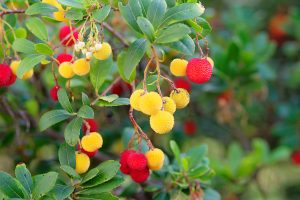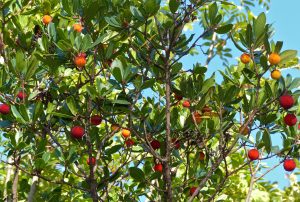Strutting its stuff on the catwalk this week is the Strawberry Tree. This isn’t a magical tree that grows Strawberries in winter but it does grow edible fruit that ripens in November and December. There really is something for every season!
For years I believed my Mama had made up the Strawberry Tree and that it must have been a tall story woven in her magical tales. I remember having Strawberry Tree honey as a child which is rare and delicious. It is known in Sardinia as a Miele Amaro (Bitter Honey) and it is definitely a delicacy. Have you ever tried it?
Often these plush, juicy fruits end up on the floor as people don’t know that you can eat them. They are bright red and ripe right now with a mild, sweet flavour. Some berries can be super sweet with up to 40% sugar! You can pop one or two straight in your mouth but don’t overdo it as they can be a narcotic if you eat too many!

An evergreen shrub within the Ericaceae family, the Strawberry Tree is native to the Mediterranean region, and western Europe and still grows wild in woodland and field edges.
Strawberry trees are related to the rose family which brings us so many succulent fruits renowned for their romantic, love-inducing properties, it’s no wonder the Strawberry Tree was sacred to both Venus and Aphrodite. I wonder if the high sugar content which turns the berries boozy as they ripen also has something to do with it!
The ancient Romans believed the Strawberry Tree possessed magical powers and finding an Arbutus branch with three berries ensured good fortune. I was delighted to discover them today in the Abbey Physic Community Garden - Growing a healthy community. It really shows you never quite know what is on your doorstep!
The poet Ovid included the Strawberry Tree in the list of fruits descended from the “The Golden Age” a time when people were content with food that grew without cultivation.
In southwest and northwest Ireland, it is known as either the “Irish strawberry tree”, or the Killarney strawberry tree – and archaeological evidence suggests it was introduced 4000 years ago by the Beaker People.
In 1586 Irish Strawberry Trees were sent to Elizabethan courtiers. By the 18th century, Arbutus unedo was well known enough in English gardens and in 1778 Thomas Jefferson brought them to his famous Monticello gardens.
Strawberry tree fruit is rich in therapeutic properties because it's a great source of vitamins, tannins and pectins being full of anthocyanins and antioxidant polyphenols. So the fruit is great for making jams and jellies
It is great for Vitamin C: 100 g of fruits contain about 180 mg, so about 3 times the amount that can be found in an orange.
Strawberry tree fruits are also a natural remedy for combating respiratory, and above all intestinal inflammation. Strawberry tree infusions are rich in antioxidants and tannins and can be used as a urinary antiseptic, while the decoction of strawberry tree leaves and roots can help to combat rheumatic pains.

In Portugal, they make a brandy out of the berries called medronho.
The green of the leaves, red of the fruit and white of the blossoms represent the three colours of the Italian flag, and for this reason, the Strawberry tree became a strong symbol of unity during the struggle for independence during the Italian Renaissance. The Strawberry tree, along with a she-bear, is portrayed in the heraldic symbol for the city of Madrid and is displayed on the flag of the city of Madrid.
The fruits of the strawberry tree can be eaten fresh or preserved in jams, liqueurs and syrups. The jam is excellent for filling whole wheat tarts prepared and the whole fruit adds a little extra oomph to cakes, biscuits and sweet buns. With the arbutus you can also prepare a particular vinegar, to be used to dress salads and for all sorts of other fun things! We're sharing our favourite recipe for Strawberry Tree Jam- if you're lucky enough to find some, give it a go and let us know what you think!
Want to fill your larder with tantalizing treats just like this one? Join the Kitchen Table revolution!
The Kitchen Table Revolution is an exclusive membership community where we learn to make the most of seasonal and foraged foods. With as little as half an hour each week, you can stock your home with perfect preserves and tantalizing treats: from delicately spiced pickled magnolia flowers to homemade blackberry and basil cordial. Spice up your culinary creativity while learning more about the world around you and connecting with a likeminded community.

Sign up to our mailing list here.
Cover photo by Tassos Sakallis on Flickr